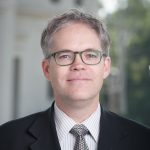
Over the past few years at Occidental our Library and Center for Digital Liberal Arts (CDLA) has been working with campus partners to develop a set of critical frameworks that collectively define what we, like a few others, have taken to calling the Digital Liberal Arts. For us, this concept encompasses the kind of “digital scholarship” that individual faculty members, librarians, and technologists have been engaged in for some time, but does so by connecting these pursuits to each other, to the curriculum, and to the digitally-mediated lived experience of the community in a residential liberal arts college.
Rather than taking our digital cultural condition as a given or focusing primarily on the value of developing students’ ability to [pullquote1 align=”right”]Curricular integration is the future of the Digital Liberal Arts at Occidental, even as we seek expand the range of student learning outcomes to include goals like data, computational, and critical visual fluencies.[/pullquote1]
manipulate digital tools, we design all of our programs so that digital culture, tools, and methods are subject to the critical inquiry of the liberal arts tradition. We want to ensure that our students learn the skills required to be successful in this digital era, but more importantly that they develop a critical perspective on the values and systems that structure their world. Insisting on this as a starting point has all sorts of implications. It means fewer stand-alone workshops on digital tools and more time scaffolding digital methods into the structure of courses. It means less emphasis on building out a single physical digital scholarship center and more attention to figuring out how digital tools and technologies can be deployed in existing classroom and research environments. For us, it also means developing a staffing model that brings together the skills of people trained in librarianship and those trained in other academic disciplines.
Of course the liberal arts tradition is neither monolithic nor static, so we look to Occidental’s specific mission and agreed-upon student learning outcomes to guide our work. For example, a number of faculty have been working in recent years to integrate undergraduate research into the curriculum to ensure that this high-impact practice reaches all students, especially underserved and first generation students. In partnership with the Associate Dean leading this charge, our CDLA is administering a grant in support of this kind of curricular integration, as we believe that digital methods will be enable students to share the fruits of their research with a public audience. This kind of curricular integration is the future of the Digital Liberal Arts at Occidental, even as we seek expand the range of student learning outcomes to include goals like data, computational, and critical visual fluencies.
Beyond the curriculum proper, we have developed a model for the Digital Liberal Arts that emphasizes connected learning. Our students come to Occidental with a range of interests that go beyond those covered in the classroom. Some want to tell stories or make music, others harbor entrepreneurial ambitions, and many want to engage in collective social justice work. These ambitions often require or are enhanced by the use of digital tools, from production equipment and social media to data visualizations and webmaking. We approach these moments as crucial to the residential liberal arts experience and as opportunities to connect student interests to broader goals. With this is mind, we have incubated or supported student organizations such as the CatAList student media service, the Open Source Club, Raw Records, the Media Activism Working [pullquote1 align=”left”]By embracing student interests outside of the classroom, we have helped many of our undergraduates accomplish their own goals while simultaneously raising the overall capabilities of the student body.[/pullquote1]
Group, and others. Hundreds of students, with support from our CDLA and often making use of the tools available through our Critical Making Studio, have developed an advanced facility with a range of digital tools. Many of these individuals become CDLA student assistants, deploying their refined digital skills in the service of supporting students and faculty using digital modes in their coursework. By embracing student interests outside of the classroom, we have helped many of our undergraduates accomplish their own goals while simultaneously raising the overall capabilities of the student body.
Developing this vision for the Digital Liberal Arts at Occidental has required organizational flexibility and the regular reallocation of resources. I can share more in future posts, but here are a few of the key projects we are working on: developing an organizational structure that explicitly supports the integration of a range of high-impact practices into the core curriculum; emphasizing the role our special collections play as a site for primary undergraduate research; communicating how our local library holdings serve the College and the broader networked library environment; shifting to a responsive collections model for the acquisition and licensing of electronic materials; reallocating budget and operational resources to support open and public scholarship; and, above all, fostering a culture of experimentation and learning that allows us to thoughtfully consider how our strategies might be adjusted.
